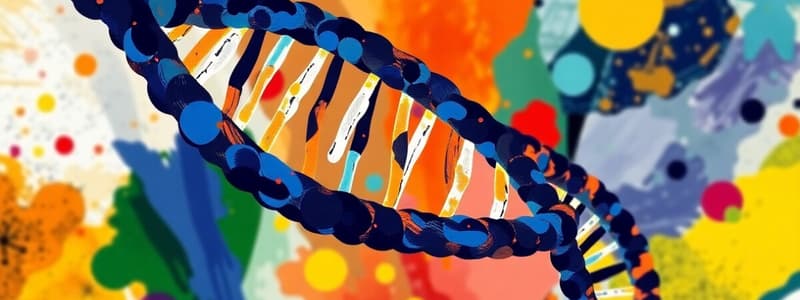Podcast
Questions and Answers
What are the two types of nucleic acids found in living systems?
What are the two types of nucleic acids found in living systems?
Deoxyribonucleic acid (DNA) and ribonucleic acid (RNA)
What is the primary function of DNA in most organisms?
What is the primary function of DNA in most organisms?
DNA acts as the genetic material.
What are the three components of a nucleotide?
What are the three components of a nucleotide?
- A nitrogenous base, a hexose sugar, and a phosphate group
- A nitrogenous base, a pentose sugar, and a phosphate group (correct)
- A nitrogenous base, a lipid, and a phosphate group
- A nitrogenous base, a protein, and a phosphate group
What is the name of the bond that links a nitrogenous base to the OH of 1'C pentose sugar?
What is the name of the bond that links a nitrogenous base to the OH of 1'C pentose sugar?
What is the name of the bond that links a phosphate group to the OH of 5'C of a nucleoside?
What is the name of the bond that links a phosphate group to the OH of 5'C of a nucleoside?
What is the term used for the end of a polynucleotide chain that has a free phosphate moiety at the 5'-end of sugar?
What is the term used for the end of a polynucleotide chain that has a free phosphate moiety at the 5'-end of sugar?
In which nucleic acid is the uracil base found?
In which nucleic acid is the uracil base found?
Who first identified DNA as an acidic substance present in the nucleus?
Who first identified DNA as an acidic substance present in the nucleus?
Who proposed the Double Helix model for the structure of DNA, based on X-ray diffraction data?
Who proposed the Double Helix model for the structure of DNA, based on X-ray diffraction data?
What is the main characteristic of the base pairing in the double-stranded DNA?
What is the main characteristic of the base pairing in the double-stranded DNA?
What is the term for the process of copying genetic information from one strand of the DNA into RNA?
What is the term for the process of copying genetic information from one strand of the DNA into RNA?
What is the name of the enzyme that catalyzes the polymerization of deoxynucleotides during DNA replication?
What is the name of the enzyme that catalyzes the polymerization of deoxynucleotides during DNA replication?
What is the name of the region in E. coli DNA where replication originates?
What is the name of the region in E. coli DNA where replication originates?
What are the three major types of RNA found in bacteria?
What are the three major types of RNA found in bacteria?
What are the three steps involved in the transcription process?
What are the three steps involved in the transcription process?
What is the term used for a polycistronic structural gene that is regulated by a common promoter and regulatory genes?
What is the term used for a polycistronic structural gene that is regulated by a common promoter and regulatory genes?
What is the name of the enzyme that hydrolyses lactose into galactose and glucose?
What is the name of the enzyme that hydrolyses lactose into galactose and glucose?
What is the name of the molecule that binds to the operator region of the lac operon and prevents transcription?
What is the name of the molecule that binds to the operator region of the lac operon and prevents transcription?
What is the name of the molecule that inactivates the lac repressor protein and allows transcription to proceed?
What is the name of the molecule that inactivates the lac repressor protein and allows transcription to proceed?
Which type of regulation is involved in the lac operon, where the repressor prevents transcription in the absence of lactose?
Which type of regulation is involved in the lac operon, where the repressor prevents transcription in the absence of lactose?
What is the main goal of the Human Genome Project?
What is the main goal of the Human Genome Project?
What is the name of the technique used to identify differences in specific regions of DNA sequences, often used in forensic science and paternity testing?
What is the name of the technique used to identify differences in specific regions of DNA sequences, often used in forensic science and paternity testing?
What is the term for variations in DNA sequences that occur at a frequency greater than 0.01 in a population?
What is the term for variations in DNA sequences that occur at a frequency greater than 0.01 in a population?
What is the name of the field of biology that deals with the rapid development of new technologies, such as computational tools for data storage, retrieval, and analysis, fueled by the Human Genome Project?
What is the name of the field of biology that deals with the rapid development of new technologies, such as computational tools for data storage, retrieval, and analysis, fueled by the Human Genome Project?
Flashcards
What is DNA?
What is DNA?
Deoxyribonucleic acid, a long polymer of deoxyribonucleotides that carries genetic information in most organisms.
What is the length of DNA?
What is the length of DNA?
The number of nucleotides (or base pairs) in a DNA molecule, determining its length.
What is a nucleotide?
What is a nucleotide?
A nitrogenous base (Adenine, Guanine, Cytosine, or Thymine) linked to a pentose sugar (deoxyribose in DNA) and a phosphate group.
What is a dinucleotide?
What is a dinucleotide?
Signup and view all the flashcards
What is chromatin?
What is chromatin?
Signup and view all the flashcards
What is DNA replication?
What is DNA replication?
Signup and view all the flashcards
What is the semiconservative model of DNA replication?
What is the semiconservative model of DNA replication?
Signup and view all the flashcards
What is DNA polymerase?
What is DNA polymerase?
Signup and view all the flashcards
What is the origin of replication?
What is the origin of replication?
Signup and view all the flashcards
What are Okazaki fragments?
What are Okazaki fragments?
Signup and view all the flashcards
What is transcription?
What is transcription?
Signup and view all the flashcards
What is a transcription unit?
What is a transcription unit?
Signup and view all the flashcards
What is a promoter?
What is a promoter?
Signup and view all the flashcards
What is a terminator?
What is a terminator?
Signup and view all the flashcards
What is a cistron?
What is a cistron?
Signup and view all the flashcards
What are exons?
What are exons?
Signup and view all the flashcards
What are introns?
What are introns?
Signup and view all the flashcards
What is splicing?
What is splicing?
Signup and view all the flashcards
What is mRNA (messenger RNA)?
What is mRNA (messenger RNA)?
Signup and view all the flashcards
What is tRNA (transfer RNA)?
What is tRNA (transfer RNA)?
Signup and view all the flashcards
What is rRNA (ribosomal RNA)?
What is rRNA (ribosomal RNA)?
Signup and view all the flashcards
What is translation?
What is translation?
Signup and view all the flashcards
What is a ribosome?
What is a ribosome?
Signup and view all the flashcards
What is gene regulation?
What is gene regulation?
Signup and view all the flashcards
What is an operon?
What is an operon?
Signup and view all the flashcards
What is the Lac Operon?
What is the Lac Operon?
Signup and view all the flashcards
What is an inducer?
What is an inducer?
Signup and view all the flashcards
What is a repressor protein?
What is a repressor protein?
Signup and view all the flashcards
What is an operator?
What is an operator?
Signup and view all the flashcards
What is the Human Genome Project?
What is the Human Genome Project?
Signup and view all the flashcards
What is DNA fingerprinting?
What is DNA fingerprinting?
Signup and view all the flashcards
What are repetitive DNA sequences?
What are repetitive DNA sequences?
Signup and view all the flashcards
What is DNA polymorphism?
What is DNA polymorphism?
Signup and view all the flashcards
Study Notes
Molecular Basis of Inheritance
- DNA is the genetic material for most organisms
- DNA and RNA are nucleic acids
- Nucleotides are the monomers of nucleic acids
- DNA is a double helix with two antiparallel strands
- DNA polymerase is the main enzyme in DNA replication
- Replication is semi-conservative
- Transcription is the process of making RNA from DNA
- The genetic code is a triplet code that determines the amino acid sequence in proteins
- Translation is the process of making proteins from mRNA
- Gene expression is regulated at various levels
- The lac operon is a model system for gene regulation in prokaryotes
DNA
- DNA is a polymer of nucleotides
- Each nucleotide has a phosphate group, a sugar (deoxyribose), and a nitrogenous base (A, T, G, C)
- The double helix structure of DNA is stabilized by hydrogen bonds between complementary base pairs (A-T and G-C)
- The two strands of the DNA run antiparallel (5' to 3' and 3' to 5')
Replication
- DNA replication is a semi-conservative process
- DNA polymerase is the key enzyme in this process
- The replication fork is the region where the two strands of DNA separate
- New DNA strands are synthesized using the parental strands as templates
- Several proteins and enzymes are involved in DNA replication
Transcription
- Transcription is the process of making RNA from a DNA template
- RNA polymerase is the key enzyme
- The process involves three stages: initiation, elongation, and termination
- Different types of RNA are produced (mRNA, tRNA, rRNA)
Translation
- Translation is the process of making proteins from mRNA
- Ribosomes are the site of translation
- Transfer RNA (tRNA) molecules bring amino acids to the ribosome
- The genetic code is a triplet code, specifying the sequence of amino acids in a protein
- Multiple enzymes and factors are involved in this process
Gene Regulation
- Gene expression is the process by which information from a gene is used to synthesize a functional gene product
- Gene regulation is the control of gene expression
- Prokaryotes often regulate gene expression through operons (e.g., the lac operon)
- Eukaryotes regulate gene expression at multiple levels
Human Genome Project (HGP)
- The HGP was an international project to determine the complete DNA sequence of the human genome
- A major goal was to identify all human genes and determine their sequences
- The project revealed that the human genome has a relatively small number of genes (compared to previous estimates)
- Many genes are represented by multiple copies of DNA segments
- Many of the discovered genes were not known to function.
Studying That Suits You
Use AI to generate personalized quizzes and flashcards to suit your learning preferences.



